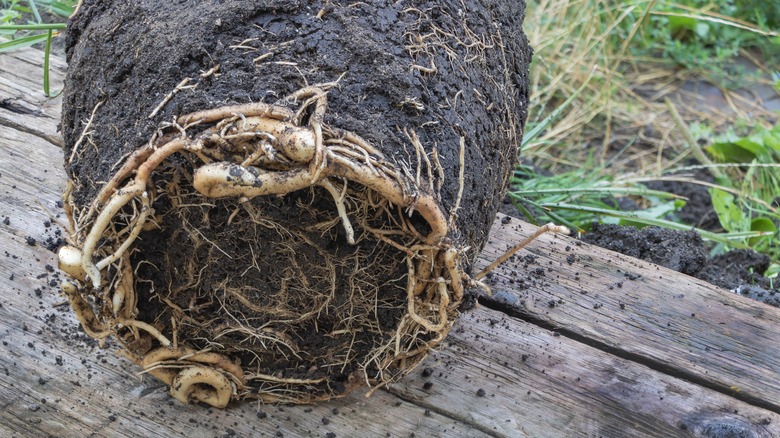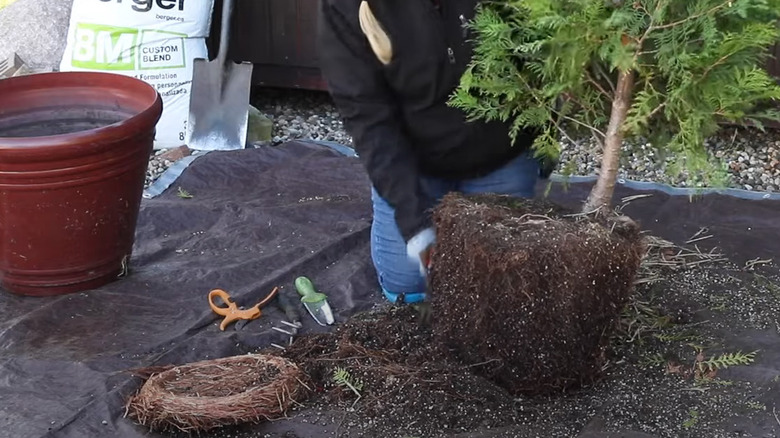Don't Forget To Do This One Thing When Planting A New Tree In Your Yard
Planting a new tree might seem simple enough. You just dig a hole in your yard and place the tree directly in it. Fill the hole back in with dirt, and pat yourself on the back for the job well done. While that might be the general rundown of things, there is one crucial step that you shouldn't forget to do before pushing the soil back around the tree. And that is setting any bounded roots free. Setting the roots free — or teasing the roots — is when you gently loosen the root ball with your fingers, delicately spreading compact roots apart so they don't stay in a tight ball. The idea behind this method is that trees growing in nature have their roots spread out in the ground; they don't grow in a tight ball. But since the tree you're currently planting was first grown in a plastic nursery pot, the roots are tightly bound in a ball. Without some teasing, they might not spread out adequately in the dirt, which later won't be able to properly support the tree.
However, not every single tree you plant needs to have its roots free. Sometimes, doing so can cause more harm than good, so knowing the caveats is important. Here is why you should tease your tree's roots before planting it — and when to skip doing so.
When it's necessary to tease roots
As a general rule of thumb, you only need to tease a plant's roots if it's root-bound in the pot. If it's not root-bound, the plant doesn't need your interception. How can you tell the difference? If you remove the tree from its plastic nursery pot and the roots are tightly wrapped into a thick, matted ball around the dirt, then that needs intervention. If you don't feather or tease those roots, they will continue to grow in this constricted way, just in the ground. This can ultimately inhibit or hurt the tree since they won't stretch out to properly anchor and support it. However, if the roots don't form a dense, jam-packed mat in the planter, then they won't require you to touch them. Instead, you can just plant the tree into the ground.
Secondly, you also want to look for circling roots. These are roots that literally begin to grow in a spiral at the bottom of the planter. They signal that the tree was left in a too-small planter for too long. If you don't cut them and tease them out, the roots can continue to grow in this fashion, eventually turning into girdling roots. These are roots that grow in a spiral around the trunk — like a girdle. After five to 10 years of growth, they can eventually kill the tree by cutting off the water or food supply to the plant.
How to tease roots
If you have a thick mat of roots or have spotted thick circling roots, then you will need to first cut the root ball to release the tightly bound roots and then tease them out. To do so, grab a clean, disinfected serrated knife and remove 1 to 2 inches from each side, turning the ball into a square. If the circling roots take up more than 2 inches of space, continue to cut until they are entirely removed. Since you are making wounds in the plant, the knife must be disinfected with rubbing alcohol beforehand to avoid spreading any possible pathogens or diseases.
Once the cuts are made, use your fingers to gently fan out the roots. Don't pull too quickly or hard, since it might break the roots. Once done, place the tree in its designated hole in the yard, and fan out the roots so they can create a strong anchor. Make sure the hole is, at a minimum, twice as big as the root ball, allowing the new roots plenty of space to stretch out. New roots will begin to grow out of the cuts you made, helping to establish the tree quickly.


